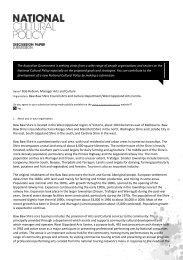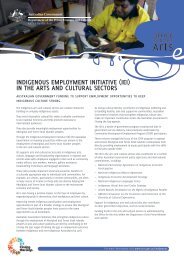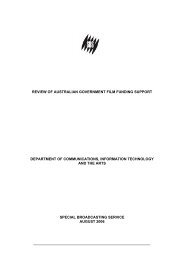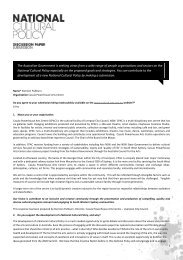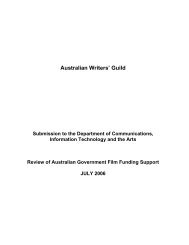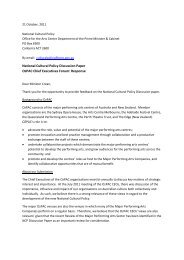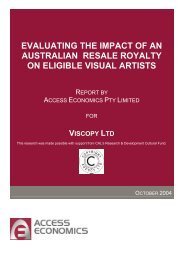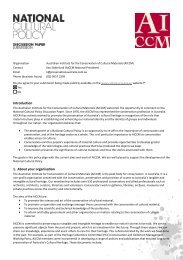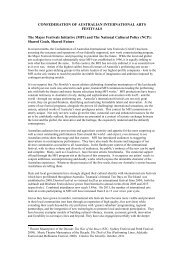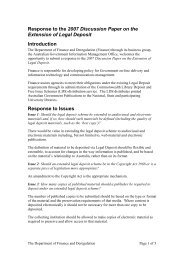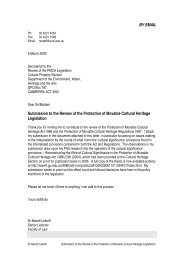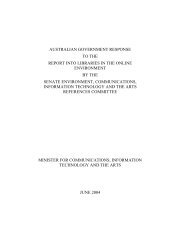National Association for the Visual Arts
National Association for the Visual Arts
National Association for the Visual Arts
Create successful ePaper yourself
Turn your PDF publications into a flip-book with our unique Google optimized e-Paper software.
If a statement about threshold had to be included in <strong>the</strong> legislation,NAVA would recommend that it should simply specify an upper limit ofno more than $3,000. However, this recommendation may be influencedby <strong>the</strong> evidence from <strong>the</strong> modelling commissioned by Viscopy fromAccess Economics. NAVA reserves <strong>the</strong> right to modify its position whenthis in<strong>for</strong>mation becomes available.11. What rate of royalty should apply and why? Also, should<strong>the</strong> royalty be set as a flat rate or on a sliding scale and why?In NAVA’s previous joint submission, we proposed a flat rate of 5%which concurs with <strong>the</strong> majority of <strong>the</strong> functional schemes internationallyand delivers reasonable returns to artists without being an undue burdenon <strong>the</strong> seller or purchaser. Our preference <strong>for</strong> <strong>the</strong> flat rate is based onachieving ease of administration and delivery of a reasonably worthwhilereturn to artists. Since resale of artists’ works in Australia rarely achieves<strong>the</strong> same dizzy heights as overseas, <strong>the</strong> concern over large amounts ofroyalty at <strong>the</strong> top level are less of an issue in Australia.However, if <strong>the</strong> payment was to be considered from a social equity pointof view, it would seem fairer <strong>for</strong> artists selling at <strong>the</strong> lower end of <strong>the</strong>range to get a proportionally higher level of royalty. NAVA would beprepared to support a sliding scale if it could be shown to deliver at least<strong>the</strong> same financial returns to artists and <strong>for</strong> at least <strong>the</strong> same number ofartists collectively as <strong>the</strong> 5% rate. It would also need to be proved not toadd to <strong>the</strong> cost of administration thus pushing up <strong>the</strong> level of <strong>the</strong> thresholdand cutting out <strong>the</strong> same artists at <strong>the</strong> lower level of sale price that <strong>the</strong>sliding scale was designed to assist.12. What type of organisation should administer anyarrangement and what factors should be used to assess andensure <strong>the</strong> per<strong>for</strong>mance of such a body? (eg. highest rate ofreturn to artists, transparency of process, administrativeefficiency, low costs etc).NAVA believes that <strong>the</strong> most suitable and ethical type of organisation <strong>for</strong>administering <strong>the</strong> royalty arrangements would be a collecting societywhich has been declared by <strong>the</strong> Attorney-General. It would be required tolodge an annual report to parliament, adhere to <strong>the</strong> standards of <strong>the</strong>Collecting Societies' Code of Conduct and have an annual reviewconducted by an independent person/s. A set of criteria would beestablished against which <strong>the</strong> standards of <strong>the</strong> collecting society'sjudgments and per<strong>for</strong>mance would be assessed. These accountability




